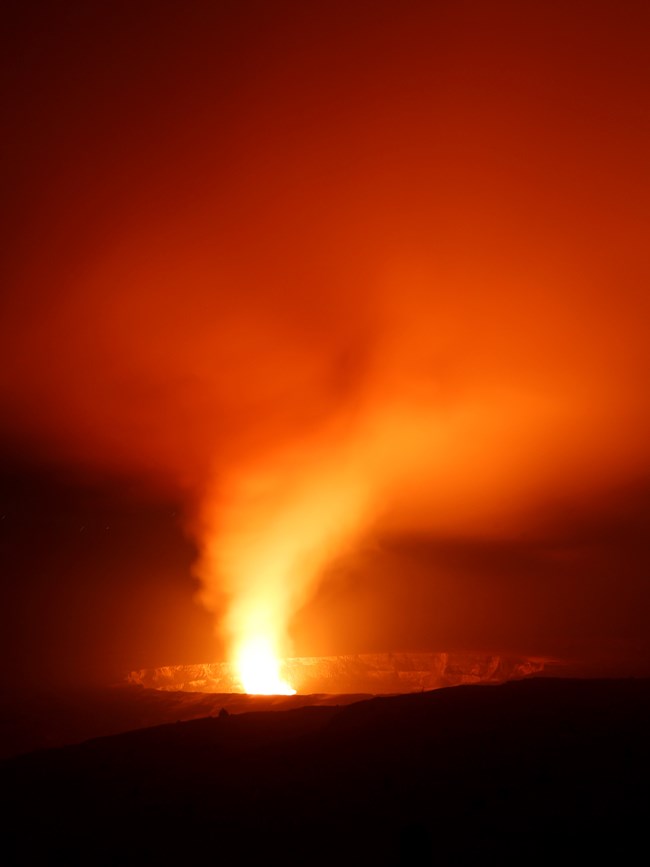Last updated: May 9, 2022
Article
Holo Mai Pele (The Journey of Pele)

“Aloha Oahu, e e!
Farewell to thee, Oahu!
Aloha o Maui, aloha, e!
Farewell to thee, Maui, farewell!
Aloha o Molokaʻi, aloha, e!
Farewell to thee, Molokaʻi, farewell!
Aloha o Lanaʻi, aloha e!
Farewell to thee, Lanaʻi, farewell!
Aloha o Kahoʻolawe, aloha, e!
Farewell to thee, Kahoʻolawe, farewell!
Ku makou e hele, e!
We stand all girded for travel
O Hawaiʻi ka ka aina
Hawaii, it seems, is the land
A makou e noho ai a mau loa aku;
On which we shall dwell evermore,”
-Pele and Hiiaka: A Myth from Hawaii
N.B. Emerson, 1915
According to tradition, the volcanic deity Pele was born across the ocean in the ancient land of Kahiki. From the moment of her birth, Pele’s father Kūwahailo, and her mother Haumea, knew that she was destined to be a powerful woman. Nāmakaokahaʻi, her eldest sister, was envious of Pele, knowing that Pele would grow up to be a powerful rival because of her beauty and mana (power).
When Pele grew older, her uncle Lonomakua gave her a digging stick. It was named Pāoa and it possessed incredible mana. He recognized that Pele was a force of nature and taught her how to use Pāoa to control her powers. One day in the absence of her uncle, Pele accidently burned the sacred lands of their home to the ground. In the wake of this disaster, her eldest sister furiously pursued her.
Pele was hastily told by her parents that she must leave to find a safe place for their family. She was instructed to carry the youngest and most beloved sister of the family, Hiʻiakaikapoliopele (also referred to as Hiʻaka), in the form of an egg to their new home. With the assistance of her siblings and oldest brother, Kamohoaliʻi, they took off into the Pacific on a voyaging canoe named Honuaiakea (the great expansive earth). As they travelled, they could hear the waves of Nāmakaokahaʻi coming forth. As long as they were there, they were helpless.
Nāmakaokahaʻi pursued them as they voyaged through the northwest Hawaiian islands and drove her family away whenever they came across land. At last they reached the island of Kaua'i. Pele dug into the earth and formed a hill called Pu'uopele, the hill of Pele. A glow of fire reflected on the clouds in the pit she made. Seeing this, her eldest sister rushed to attack. The tidal waves from the sea forced them to flee to the island of Oʻahu.
On Oʻahu, once more Pele dug. She made a fire pit as she had done before, but salt water from Nāmakaokahaʻi rose into it and drowned her flames. Today we call this place Leʻahi or Diamond Head.
Onto Molokaʻi and Maui, Pele tried again and again to no avail. Finally on the western slopes of Haleakalā in Maui, Pele had gained the strength and the confidence to fight Nāmakaokahaʻi alone until death. This long battle was fought hand to hand until Nāmakaokahaʻi tore the body of Pele. She broke Pele’s bones into pieces which lie to this day in a district called Kahikinui. There is still a mass of broken lava that is named Nāiwiopele, the bones of Pele.
While rejoicing at the death of Pele, Nāmakokahaʻi looked in a distance and saw the volcano known as Mauna Loa on the island of Hawaiʻi. It was erupting torrents of lava from its raging caldera. At this moment she knew it was the ʻuhane (spirit) of Pele, on the neighboring island, and that she could never overcome her.
After reaching the island of Hawaiʻi, Pele continued on her migration toward the volcano Kīlauea. On its summit, Pele decided to test the land by digging the ground with Pāoa. The omens appeared favorable and Pele decided this would be her permanent home in the crater of Halemaʻumaʻu.
There, in Halemaʻumaʻu, Pele is said to still reside.
